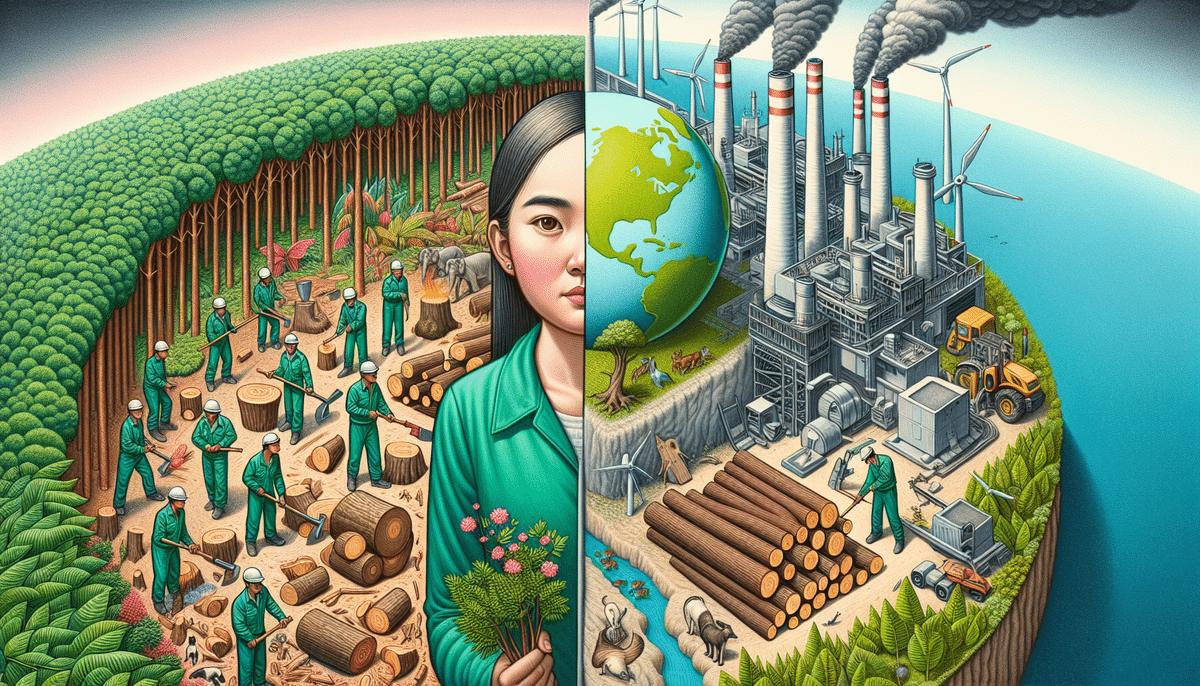Stora Enso vs Georgia-Pacific: A Comprehensive Comparison
Introduction to the Pulp and Paper Industry
The pulp and paper industry is a cornerstone of modern society, supplying essential materials for products like books, newspapers, tissue paper, and packaging. As the global population grows, the demand for these products increases, solidifying the industry's status as one of the largest worldwide.
Industry Overview
The pulp and paper sector encompasses the harvesting of trees, processing them into pulp, and manufacturing a variety of paper products. It is primarily divided into two segments:
- Pulp Manufacturing: Converts wood into pulp through chemical or mechanical processes, separating fibers to produce high-quality pulp used for paper, tissue, and packaging materials.
- Paper Manufacturing: Transforms pulp into paper by forming sheets, drying, and finishing to create products for printing, writing, packaging, and specialized industrial uses.
Environmental impact is a significant concern in this industry, prompting many companies to adopt sustainable practices such as recycling, reducing water and energy consumption, and utilizing renewable materials.
Company Histories: Stora Enso and Georgia-Pacific
Stora Enso
Founded in 1998 through the merger of Sweden's Stora AB (established in 1288) and Finland's Enso Oyj (founded in 1872), Stora Enso is one of the world's oldest and largest pulp and paper companies. With operations in over 30 countries and a workforce exceeding 23,000 employees, the company is a leader in sustainable forest management and innovative biomaterials.
Stora Enso is committed to reducing its greenhouse gas emissions by 50% by 2030 and achieving carbon neutrality by 2050. The company also aims for 100% traceability of its wood and pulp sources by 2030, reflecting its dedication to responsible sourcing.
Georgia-Pacific
Georgia-Pacific, established in Augusta, Georgia, in 1927, began as a lumber company and has since expanded into one of the world's leading manufacturers of tissue, packaging, and building products. With over 30,000 employees and operations in more than 180 locations globally, Georgia-Pacific emphasizes product development and process innovation.
The company aims to reduce its greenhouse gas emissions by 25% by 2025 and has been recognized by the Forest Stewardship Council for its sustainable forestry management efforts.
Business Models: Stora Enso vs Georgia-Pacific
While both companies are prominent in the pulp and paper industry, their business models exhibit distinct focuses:
- Stora Enso: Emphasizes sustainable forest management and offers a diverse range of products, including paper, packaging, and biomaterials. The company prioritizes sustainable growth and innovation to meet evolving customer demands.
- Georgia-Pacific: Focuses on tissue, packaging, and building products, with a strategy centered on high-quality product delivery and innovation through research and development. Although sustainability is a key focus, it is less pronounced compared to Stora Enso's comprehensive commitment.
Competitive Landscape in Pulp and Paper Manufacturing
The pulp and paper industry is highly competitive, featuring major players such as International Paper, WestRock, UPM, and Sappi. Competition is driven by factors including product quality, pricing, innovation, and customer service.
Financial Performance: Stora Enso vs Georgia-Pacific
Both Stora Enso and Georgia-Pacific are publicly traded companies, allowing for transparent comparisons of their financial health. As of 2023:
- Stora Enso: Reported a revenue of approximately $11 billion in 2022, showcasing steady growth and a strong market presence.
- Georgia-Pacific: Reported revenue exceeding $20 billion in 2022, maintaining its position as a leading manufacturer in the industry.
Investors also consider metrics such as earnings per share, share price performance, and profitability ratios to assess the companies' financial stability and growth potential.
Sustainability Initiatives vs Environmental Impact
Sustainability is a key differentiator between the two companies:
- Stora Enso: Dedicated to sustainable forest management, targeting carbon neutrality by 2050, and developing biomaterials from renewable sources. The company has pioneered low-carbon and biodegradable packaging solutions.
- Georgia-Pacific: While committed to reducing greenhouse gas emissions and promoting responsible forestry, Georgia-Pacific has faced criticism for its environmental impact, particularly concerning the use of virgin pulp and related pollution issues. Although improvements have been made, the company continues to work towards enhancing its sustainability profile.
The Impact of COVID-19 on the Pulp and Paper Industry
The COVID-19 pandemic had a profound effect on the pulp and paper sector. The surge in online shopping led to increased demand for packaging materials, while the closure of offices and schools reduced the need for printing and writing paper.
According to the PwC Global Pulp and Paper Industry Report 2023, the industry experienced varied impacts, with packaging segments recovering faster than traditional paper products.
Key Challenges for Stora Enso and Georgia-Pacific
Both companies face several challenges in the evolving pulp and paper landscape:
- Sustainability Demand: Rising consumer and regulatory demand for sustainable products requires significant investments in research, development, and sustainable production practices.
- Rising Competition: Emerging markets, particularly in China and India, are expanding their pulp and paper industries, offering competitive pricing and increasing market rivalry.
- Technological Advancements: Rapid technological changes necessitate continuous adaptation to maintain efficiency and competitiveness.
Innovation Strategies: Stora Enso vs Georgia-Pacific
Innovation is vital for maintaining competitiveness in the pulp and paper industry:
- Stora Enso: Invests heavily in research and development, focusing on sustainable innovations such as biodegradable packaging and advanced biomaterials. The company collaborates with research institutions to drive sustainable product development.
- Georgia-Pacific: Prioritizes product development and process innovation through its dedicated innovation centers. Collaborations with universities and research institutions help in developing new products and enhancing manufacturing technologies.
Technological Advancements Shaping the Future
Technology is increasingly pivotal in pulp and paper manufacturing. Innovations like the Internet of Things (IoT) and artificial intelligence (AI) enhance production efficiency and sustainability. Emerging technologies such as biotechnology and nanotechnology are set to revolutionize the industry by introducing new materials and reducing environmental impacts.
According to a McKinsey & Company report, these technological advancements will drive significant improvements in production processes and product innovation, positioning companies for future success.
Marketing Strategies Comparison
Effective marketing is crucial for differentiation and customer engagement in the pulp and paper industry:
- Stora Enso: Utilizes a mix of advertising, trade shows, and social media to highlight its sustainable products and innovative solutions. Emphasizes building strong customer relationships through exceptional service and sustainability narratives.
- Georgia-Pacific: Employs similar marketing tactics but places a stronger emphasis on showcasing high-quality products and process innovations. Focuses on product excellence and customer relationship management as key marketing pillars.
Employee Practices: Stora Enso vs Georgia-Pacific
Employee practices significantly influence corporate reputation and operational success:
- Stora Enso: Committed to diversity and inclusion, setting targets to increase the representation of women and minorities in leadership roles. Offers extensive training and development programs, fostering a supportive and growth-oriented work environment.
- Georgia-Pacific: Has faced criticism regarding employee safety and treatment, including lawsuits and fines related to workplace injuries. While offering various benefits and perks, the company needs to address areas such as training and safety measures to improve its employee relations.
Future Outlook for the Pulp and Paper Industry
The pulp and paper industry is on the cusp of significant transformation, driven by both challenges and opportunities:
- Sustainability: Meeting the growing demand for sustainable products and minimizing environmental impacts through innovative and responsible practices.
- Technological Integration: Adopting advanced technologies to enhance production efficiency, reduce waste, and develop new product lines.
- Global Competition: Navigating the competitive landscape with the emergence of new markets and maintaining a strong market presence against rising competitors.
Companies that effectively address these factors, invest in sustainability, and continue to innovate are well-positioned for long-term success.
Conclusion: Which Company Leads the Future of the Industry?
Both Stora Enso and Georgia-Pacific are influential players in the pulp and paper industry. However, Stora Enso distinguishes itself with a robust commitment to sustainability and innovation, positioning itself favorably in an industry increasingly focused on environmental responsibility.
While Georgia-Pacific excels in product development and manufacturing innovation, it faces challenges related to sustainability and employee practices. These factors may impact its long-term competitiveness compared to Stora Enso.
Ultimately, the ability to adapt to market changes, embrace sustainable practices, and drive continuous innovation will determine which company excels in the future. Stora Enso's proactive approach in these areas suggests it is well-positioned for sustained success in the evolving pulp and paper industry.






















